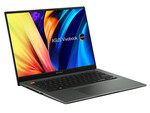Asus VivoBook S 14X S5402Z
Ausstattung / Datenblatt

Primary Camera: 0.9 MPix
Preisvergleich
Durchschnitt von 3 Bewertungen (aus 3 Tests)
Testberichte für das Asus VivoBook S 14X S5402Z
Obwohl es „nur“ ein Vivobook ist, ist das Vivobook S 14X mit demselben 14,5-Zoll-OLED-Panel von Samsung ausgestattet wie das Zenbook Pro 14 Duo und bietet damit ein ähnliches Seherlebnis zu einem viel günstigeren Preis. Wenn Sie nicht mehr als 1.000 USD für ein Ultrabook ausgeben möchten, dann bietet Ihnen dieses Asus-Modell eine Menge für Ihr Geld.
Quelle: The Verge
 EN→DE Archive.org version
EN→DE Archive.org versionThe Vivobook S 14X OLED is notable for one thing: its screen. That such an exceptional screen is available at such a low price is a great thing to see. That it’s being paired with an H-series processor is all the more notable. But I very much question the target audience; how many people who need an H-series processor and are willing to sacrifice portability for its power are content with integrated graphics? My best shot at labeling this group is: someone who really wants a cheap OLED for media consumption. This might be a great option for a college film studies major. More money for an XPS can get you better speakers, battery life, build quality, and graphics — but if you are very budget-constrained and the screen is your top priority, then sure, get this. For everyone else, Vivobook is a great proof of concept but less practical as a purchase. Devices that are exceptional in theory should also work in practice. They are not artwork; people use them every day. With battery life this bad, it is not a practical purchase. It is quite cool, though.
Einzeltest, online verfügbar, Lang, Datum: 04.10.2022
Bewertung: Gesamt: 60%
Quelle: XDA Developers
 EN→DE Archive.org version
EN→DE Archive.org versionThe problem with the Asus Vivobook S 14X is that I have a hard time figuring out exactly what category this fits in. I wouldn’t call it a creator laptop; after all, I edited all of these photos on it and frankly, it was lacking when it was on battery life. And at the same time, people that want a productivity laptop would be better served with a U- or P-series processor. Still, you do get a 2.8K 120Hz screen for $1,100, so there’s a lot of value there.
Einzeltest, online verfügbar, Lang, Datum: 02.07.2022
Quelle: Digital Trends
 EN→DE Archive.org version
EN→DE Archive.org versionThe Asus Vivobook S 14X is a challenging laptop to rate. Its performance is inconsistent and generally slower than it should be given the fast CPU, and its battery life is poor. Its build quality is also a bit less rigid than I like. But it’s only $1,100 with a competitive configuration and a spectacular 120Hz OLED display that’s better than those on much more expensive laptops. In the end, the performance and battery life hold me back from recommending the Vivobook S 14X. You might have to spend more money, but there are better 14-inch laptops available today.
Einzeltest, online verfügbar, Lang, Datum: 12.06.2022
Bewertung: Gesamt: 60%
Kommentar
Modell: Asus VivoBook S 14X jetzt bei Amazon
Intel Iris Xe G7 96EUs: Integrierte Grafikkarte (in Tiger-Lake G7 SoCs) der Gen. 12 Architektur mit 96 EUs.
Diese Klasse ist noch durchaus fähig neueste Spiele flüssig darzustellen, nur nicht mehr mit allen Details und in hohen Auflösungen. Besonders anspruchsvolle Spiele laufen nur in minimalen Detailstufen, wodurch die grafische Qualität oft deutlich leidet. Diese Klasse ist nur noch für Gelegenheitsspieler empfehlenswert. Der Stromverbrauch von modernen Grafikkarten in dieser Klasse ist dafür geringer und erlaubt auch bessere Akkulaufzeiten.
» Weitere Informationen gibt es in unserem Notebook-Grafikkartenvergleich und der Benchmarkliste.
i7-12700H: Auf der Alder-Lake-Architektur basierender High-End Mobilprozessor. Bietet 6 Performance-Kerne und 8 Effizienzkerne und kann 20 Threads gleichzeitig bearbeiten. Der maximale Turbo-Takt der P-Kerne beträgt 4,7 GHz. Weiters unterstützt die CPU vPro Essentials.» Weitere Infos gibt es in unserem Prozessorvergleich Vergleich mobiler Prozessoren und der Prozessoren Benchmarkliste .

